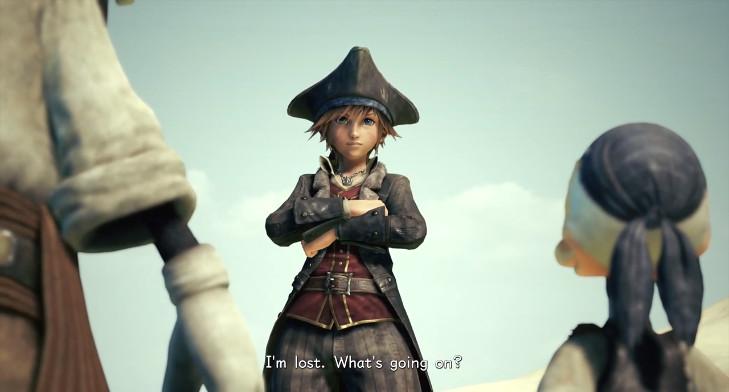During the opening hours of Kingdom Hearts III, the extremely long-in-the-making collaboration between Disney and Square Enix that came out in North America on PlayStation 4 and Xbox One last week, each player must search their own heart for the answer to one question: Do I need to know what’s happening here?
It’s probably possible to attain a total understanding of the story of Kingdom Hearts, which has stretched over about a dozen games released on roughly seven platforms in a span of 17 years and approximately 200 hours of playtime. (Specifying precisely how many Kingdom Hearts games there are, or on how many platforms they’ve appeared, raises thorny ontological questions about what qualifies as a game.) It’s just a matter of how much time and effort it takes to reach that level of enlightenment, and whether the research is worth the reward. The good news is that even though the latest sequel’s inscrutable story will strike some sizable proportion of players as hot nonsense, the game is still good. And that dichotomy exposes both the best and the worst thing about video games: Given a fun foundation of compelling mechanics, making sense is still optional.
When it comes to Kingdom Hearts, I’m a relatively low-information player, albeit better-versed in the series than someone who’s wondering whether to dive in for the first time. I’ve played Kingdom Hearts and Kingdom Hearts II, which a novice might mistakenly believe to supply the bulk of the backstory of Kingdom Hearts III. (Not even close.) I haven’t skipped a single cutscene. I’ve read and watched some of the many online plot explainers, which were presumably produced by people who understood the story (or cribbed from earlier explainers and convincingly pretended to). Essentially, I’ve made what one of baseball’s official scorers might classify as an “ordinary effort” to follow along. Even so, this is the still that best sums up my Kingdom Hearts III story experience:

Although the game front-loads a series of semi-explanatory cutscenes and includes the Kingdom Hearts Memory Archive (a 20-minute recap of previous events), I’m hard-pressed to provide a synopsis of Kingdom Hearts III. The story is set after the events of the 2012 Nintendo 3DS title, Kingdom Hearts 3D: Dream Drop Distance. Its returning protagonist, spiky-haired Sora, wields a keyblade, which is a blade in the shape of a key. (That part is plain enough.) He’s lost his previous powers and has begun the painstaking process of leveling up again, a standard setup for video game sequels that have to justify the presence of a progression system despite the player-controlled character already having become a badass in preceding appearances. While making ample time for frivolous recreation, Sora is trying to rescue Aqua, a character from previous games who’s lost in the Realm of Darkness, which contains Kingdom Hearts (basically, a huge, heart-shaped MacGuffin). Also, he has other characters from previous installments locked inside his own heart, which sounds like a serious condition but doesn’t seem to trouble him most of the time.
Sora, backed by constant sidekicks Donald and Goofy, is confronted at every turn by members of Organization XIII, a shadowy group with mysterious motives whose sneering members boast names such as Xigbar, Marluxia, and Larxene. These bad guys and gals unleash wave after wave of Heartless, enemies that exist to be bashed by keyblades and bestow experience points upon the player. Behind the whole existential tussle is a central antagonist, Xehanort, who is sort of (but not quite) the same as the central antagonists from Kingdom Hearts and Kingdom Hearts II, even though they had different names and hairdos. There are many minutes of blather about hearts of darkness, hearts of light, and making a Heartless who looks like a human. Cloning and time travel are involved. To its credit, the game pokes fun at its own impenetrability somewhat frequently, alluding to the franchise’s convoluted titles and having characters comment on their confusion and on how much time has elapsed since earlier events.
I’ve spent too much time immersed in the arcana of other fictional properties to question why someone would devote mental storage space to the intricacies of Kingdom Hearts; we all have certain series that resonate on the same frequency as our inner geek. In a sense, it’s unfair to fault a game for relying so heavily on its own lore, even though a lot of that lore dates to the early 2000s and the rest is scattered across more titles than all but the most dedicated Kingdom Hearts faithful could consume. But be warned: You can’t come in cold and expect to see this story as much more than an opaque piece of fan fiction you’d probably be embarrassed to discover on your high-school hard drive decades later.
If your first exposure to Kingdom Hearts happened in high school, though, then you’ll welcome being transported back to that time in your life. By taking so long to arrive, Kingdom Hearts III generated nostalgia for the series itself, separate from any attachment to the Disney source material. To care deeply about the details of this conclusion to Kingdom Hearts’ Dark Seeker Saga—as director Tetsuya Nomura styles this supposed first phase of the series—you almost have to have been there from the beginning.
If you missed the earlier titles, then the path to appreciating Kingdom Hearts III is simple. Root for Sora and most of the Disney characters, many of whom are more endearing in their Kingdom Hearts incarnations than they are in their original guises. Root against the emissaries of Organization XIII, who graciously stick to a dress code of matching, tightly tapered, black, zippered robes, which makes them easy to identify. Every time Sora sees one of his adversaries, he shouts their name—like, “Larxene!”—so you don’t have to try to remember which is which. Dozens of scenes circle the hokey message that feelings and friends are important. This is your basic battle between good and evil and very literal light and darkness.
As always, then, Kingdom Hearts III drafts in Disney’s wake. The conceit of Kingdom Hearts is that Sora exists in the same universe as the Disney/Pixar cast of characters, which provides an excuse for him to tour established settings and story lines from fondly remembered films, this time including Hercules, Toy Story, Tangled, Frozen, Pirates of the Caribbean, Big Hero 6, and Monsters, Inc. This piecemeal structure doesn’t lend itself to a coherent narrative or clear character motivations—why are we picking flowers for Rabbit from Winnie the Pooh when the world is ending, again?—and the dialogue is overly earnest. Although the cast of voice actors is as star-studded as usual, some scenes are marred by odd enunciation and unnatural pacing, and there’s an occasional jarringly dissonant impersonation (or even, in the case of Phil from the Hercules stage, a prominent personality who stays conspicuously silent).
On the whole, though, the game is suffused with a laudable devotion to authenticity. We like these characters and we like these worlds, and it’s not noticeably less thrilling to interact with them than it was in 2002. Most of the game’s almost 12 hours of cutscenes—a little more than a third of its full length, and about as much time as it would take to binge all five Pirates of the Caribbean films, which I wouldn’t recommend—are devoted to Disney-related material, which makes the Organization XIII content tolerable. The leap from the PS2 hardware that hosted the first two console Kingdom Hearts games to current-generation technology has narrowed the visual gap between the games and the movies, heightening the player’s sense of immersion. The soundtrack—which features a score and a theme composed by series veterans Yoko Shimomura and Utada Hikaru, respectively (with an assist from Skrillex)—deepens the Disney connection with liberal use of movie motifs.
At its core, keyblade combat in Kingdom Hearts III is still simplistic, especially on the standard difficulty level. As my friend James, a committed Kingdom Hearts enthusiast, advises, “Just keep mashing ‘X’ and generally things work out.” (In an early level, I accidentally disabled all of my magical abilities and still slashed my way forward without noticing anything amiss.) There are other ways to tackle the Heartless—magic attacks, summons, swappable weapons, and joint attacks performed in concert with other party members, some of which take the form of eye-catching but obnoxiously time-consuming Disney theme park rides—but button-mashing alone is mesmerizing, and both faster and flashier than it’s ever been before.
Although the game retains the same rhythm regardless of the stage, cycling from cutscene to exploration to cutscene to combat sequence to cutscene again, variety remains central to the Kingdom Hearts experience. Not just the visual variety that come from bouncing between the snowy cliffs of Arendelle and the crowded streets of San Fransokyo, dropping and picking up party members at every stop, but also in the diversity of gameplay, which is more of a mashup than ever. First-person mech carnage, battles between tall ships, arcade-style flight combat, snowboarding on the back of a shield: For at least a few minutes, Kingdom Hearts III dips a toe into every action genre, melding its string of quick-twitch set pieces with the more deliberate RPG trappings of character and equipment customization.
These pieces don’t interlock seamlessly. Flying from level to level in the Gummi Ship, a series staple, can be tedious, and some minigames feel like chores. Befitting a project that took an unreasonably long time to complete, Kingdom Hearts III is almost overstuffed with collectibles, detours, and crafting and customization options, some of which can be safely skirted by casual players. Like Mickey Mouse in the Sorcerer’s Apprentice short from Fantasia, the game is perpetually on the point of losing control of its creations. But it keeps being bailed out by the inherent appeal of its characters, its unabashed zaniness, its kinetic combat, and our desire to see what’s in store beyond the next save point. Kingdom Hearts is high on its own supply, and it’s tempting to try some of what the series is smoking.
Although it takes its time getting there, Kingdom Hearts III does build up to a suitably epic crescendo of boss battles and story reveals that deliver an emotional payoff for players who are in deep enough to appreciate them. But ultimately, much of the pathos the game manages is built on the backs of the movies it samples and plunders. The Disney canon is the narrative trellis that keeps the complex Kingdom Hearts mythology from collapsing. Whatever heft the postmodern pastiche provides is borrowed from film.
In that respect, Kingdom Hearts hearkens back to the age-old tension of gaming. Its story isn’t artful enough to stand on its own, but it doesn’t have to, because its participatory elements offer an appeal that no movie could mimic. In the years since the first Kingdom Hearts, games have begun to tell rich stories as adeptly as other, more easily scripted entertainment media, rather than relying on gameplay alone to propel players. In its own heart, though, Kingdom Hearts hasn’t changed; at a fundamental level, it’s an expanded and prettified PS2-period game. It’s an era that’s fun to revisit, but it’s also an era that subsequent storytellers have learned to transcend.
